The Institute collects individual issues of newspapers that cover the events of the American Revolution, post-war commemorations and the activities of the Society of the Cincinnati. Newspapers in the Revolutionary era served as the main source of information about events across the states, such as eyewitness reports from battles, letters and breaking news. People would either buy the paper or listen to it read aloud in town.
The format and style of late eighteenth- and early nineteenth-century newspapers are very different from today’s papers. Headlines are non-existent; rather, italics or small capital letters are used in a column to indicate an item of interest. Advertisements are scattered throughout the pages and give insights into popular books—Regulations for the Order and Discipline of the Troops of the United States by baron von Steuben is advertised for purchase in a 1789 paper—as well as goods and services for sale.
The centerpiece of the Institute’s newspaper collection is the Hamilton Newspaper and Ephemera Collection of Antonia Chambers, Esq., which contains newspapers featuring articles on the life and career of Alexander Hamilton and Eliza Hamilton’s work to promote and protect his legacy. The collection chronicles events ranging from his valorous action at Yorktown in 1781 to the Hamilton-Burr duel and his death in 1804. Other highlights of the Institute’s newspaper collection include contemporary European newspapers reporting on the war in America, newspapers from the 1750s covering the French and Indian War, detailed descriptions of battles, and coverage of Society of the Cincinnati meetings and toasts.
The following newspapers, and others, are available on our Digital Library.
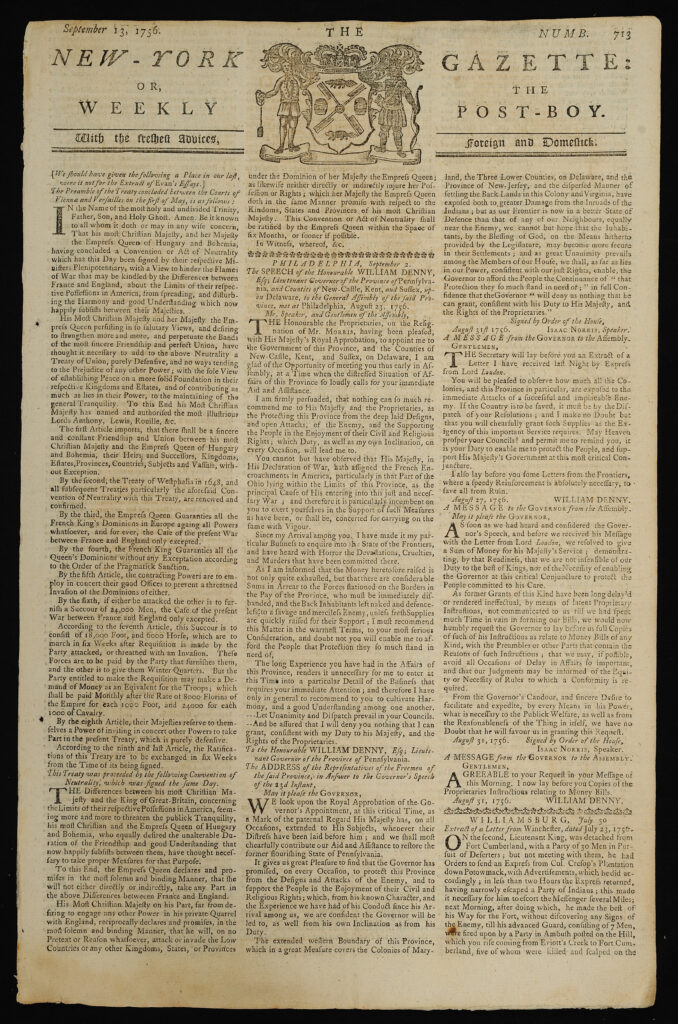
The New York Gazette or, the Weekly Post-Boy
New York: Printed by J. Parker and W. Weyman, September 13, 1756The Robert Charles Lawrence Fergusson Collection
The New-York Gazette, or, The Weekly Post-boy was a prominent New York newspaper that would go on to lead opposition to the Stamp Act. The two issues in the Institute library holdings cover the French and Indian War in the 1750s. This issue features a piece referring to Col. George Washington disciplining an officer for poor judgement that led to an Indian ambush at Winchester, Virginia, resulting in the loss of five soldiers.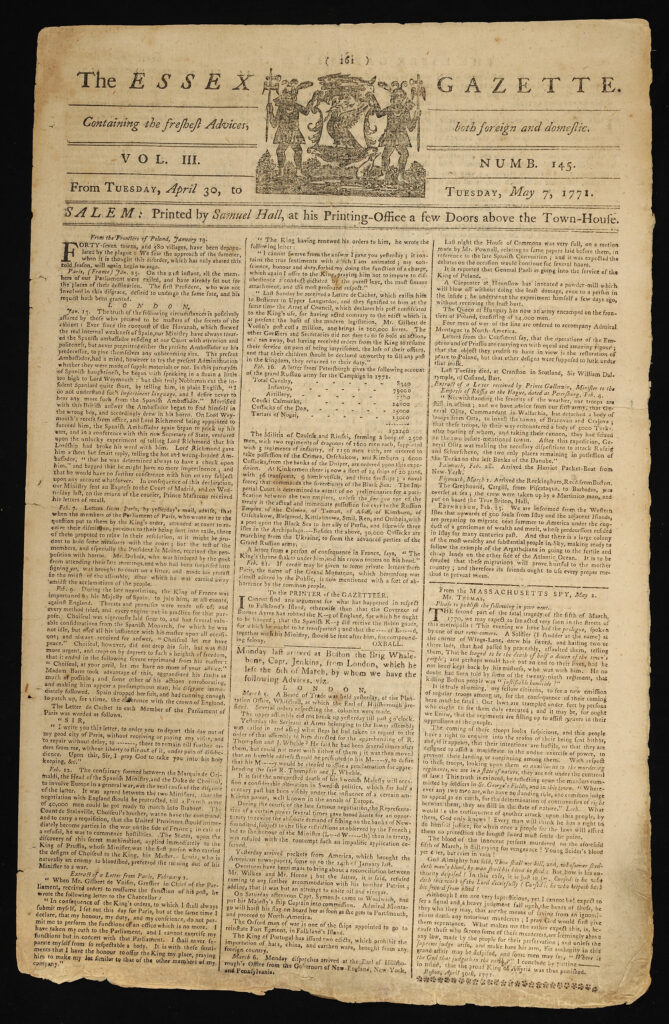
The Essex Gazette
Salem: S. Hall, April 30-May 7, 1771The Robert Charles Lawrence Fergusson Collection
Marking the one-year anniversary of the Boston Massacre, this issue features an excerpt from The Massachusetts Spy recounting the event and noting the unease of Bostonians with the growing number of occupying troops on the streets of the city. The writer reported, “It is truly alarming, my fellow citizens, to see a new emission of regular troops among us, for the consequence of their coming here must be fatal.”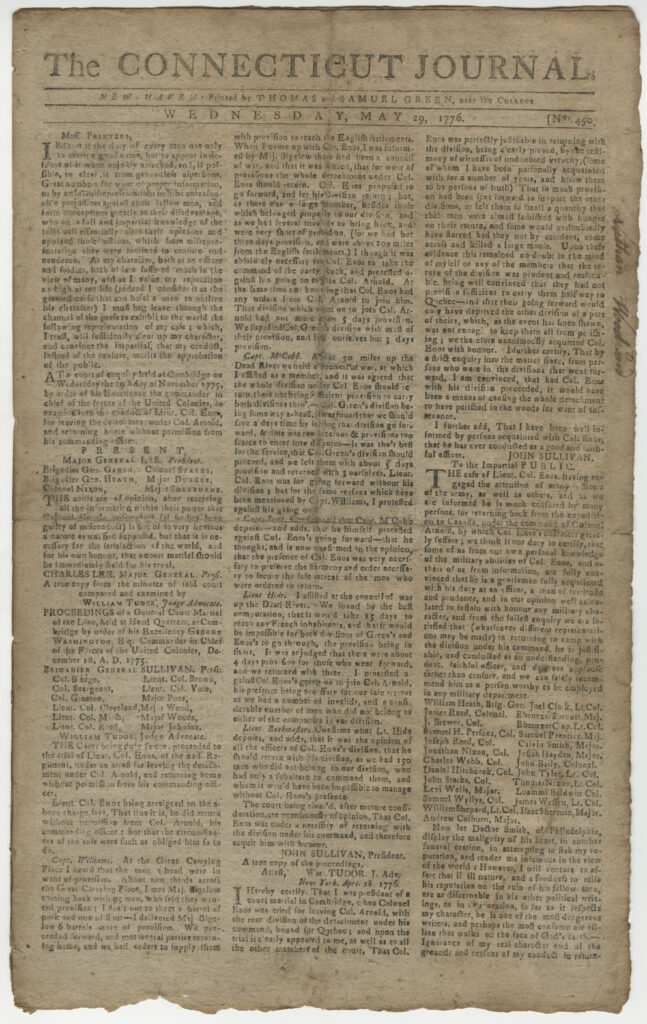
The Connecticut Journal
New Haven: Printed by Thomas and Samuel Green, May 29, 1776The Robert Charles Lawrence Fergusson Collection
This issue contains reports from New England, New York and London. Most significant is the front-page report covering the proceedings of the court martial of Col. Roger Enos, a Connecticut officer who fought at Bunker Hill and then joined Gen. Benedict Arnold on the march through the Maine wilderness to Quebec in 1775. Enos was charged for “leaving the detachment under Col. Arnold, and returning home without permission from his commanding officer.” Enos defended his decision to leave: “True it is, he did return without permission from Col. Arnold, his commanding officer : but that the circumstances of the case were such as obliged him so to do.” Enos was later acquitted and returned to service.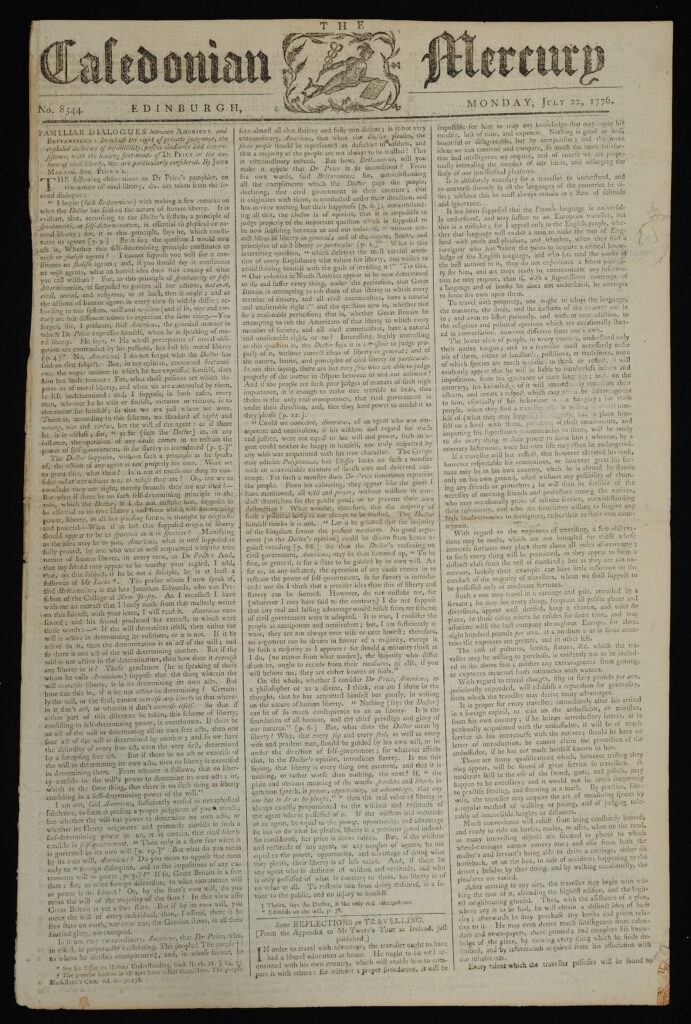
The Caledonian Mercury
Edinburgh: Printed for W. Rolland by William Adams Junior, July 22, 1776The Robert Charles Lawrence Fergusson Collection
This Scottish newspaper features several extracts from letters detailing the events of the Revolution. Notably, there are extracts detailing the British fleet leaving Halifax, Nova Scotia, for New York, the aftermath of the New York campaign and the shipment of ten thousand barrels of gunpowder heading for America for use by “his Majesty’s forces there.”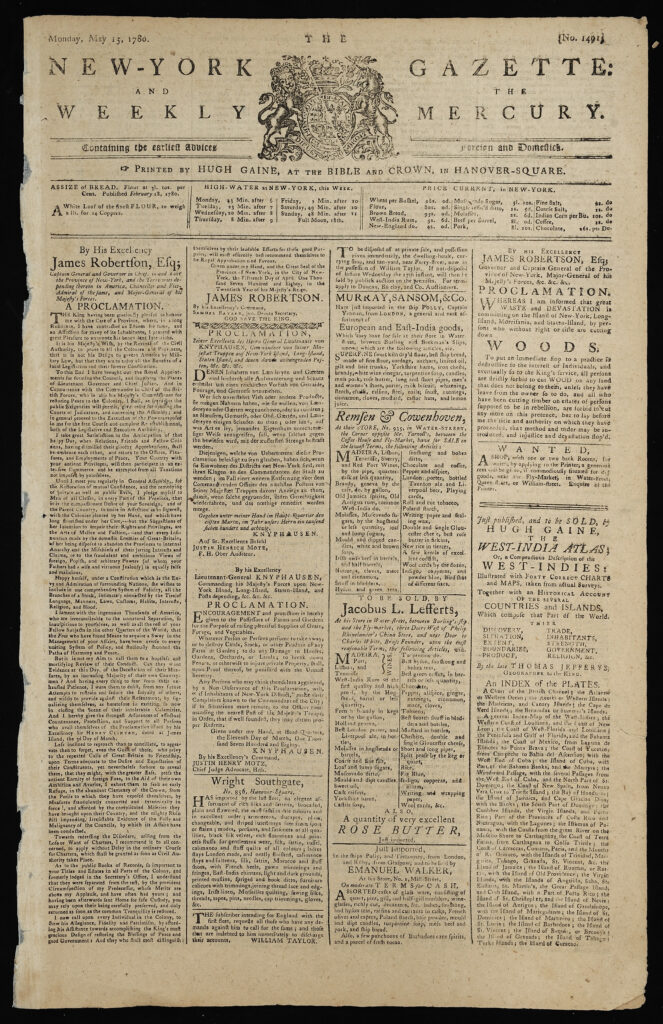
The New-York Gazette, and the Weekly Mercury
New York: H. Gaine, May 15, 1780The Robert Charles Lawrence Fergusson Collection
Beginning its run in 1768, this newspaper and was considered a pro-independence newspaper through the British invasion of New York when Hugh Gaine, the publisher, fled to Newark, New Jersey, to continue publishing. Upon his return to New York City in November 1776 and having decided that the British would win the war, Gaine began publishing The New-York Gazette as a loyalist paper. This issue contains foreign intelligence from “Petersburgh” to assist Great Britain “against her revolted colonies in America, with a certain number of ships and troops,” as well as other pro-British articles.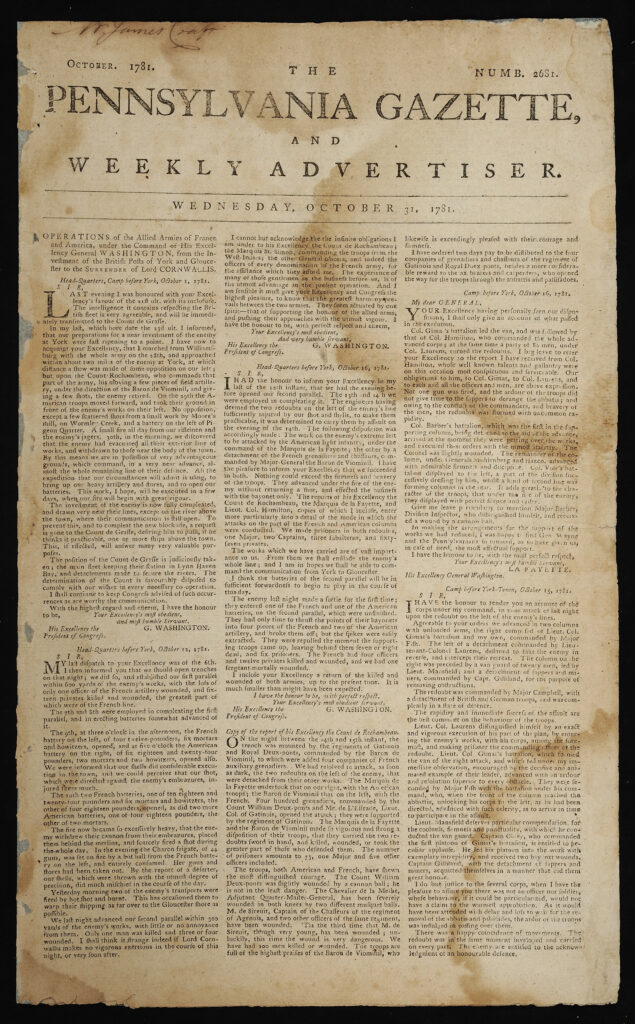
The Pennsylvania Gazette
Philadelphia: Samuel Kleimer, October 31, 1781The Hamilton Newspaper and Ephemera Collection of Antonia Chambers, Esq.
This paper, published just twelve days after the British surrender at Yorktown, includes many letters to and from George Washington about the siege. The account of Alexander Hamilton’s valiant performance is one of the earliest appearances of his name in the press. Also highlighted are the actions of John Laurens, the comte de Rochambeau and the marquis de Lafayette. Additionally, this paper published a “Return of the Killed and Wounded of the French Troops” and a “Return of the Killed and Wounded of the American Army.” A series of letters between Washington and Cornwallis, and the Articles of Capitulation, ends this issue.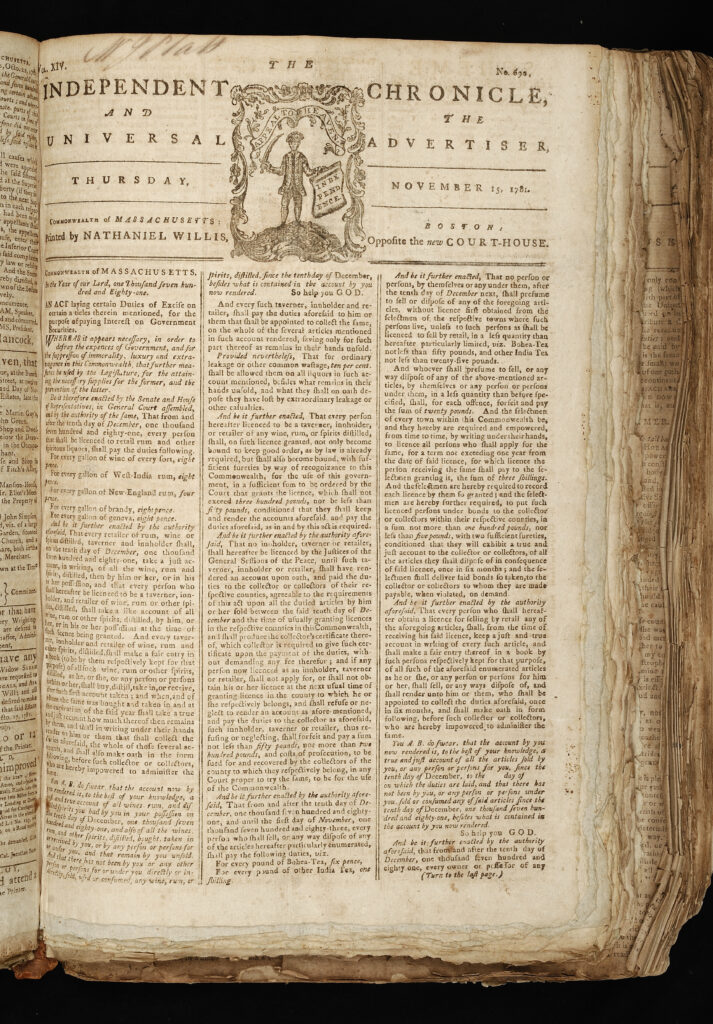
The Independent Chronicle and the Universal Advertiser
Boston: Powars & Willis, November 15, 1781The Robert Charles Lawrence Fergusson Collection
Bound with the complete 1781 and 1782 issues, this issue covers the siege of Yorktown and praises the actions of the French officers, including the comte de Rochambeau, and documents the surrender of Cornwallis in numerous published letters. It announced that Congress recommended “to set apart the thirteenth day of December next, to be religiously observed as a day of Thanksgiving and Prayer.” A description from Boston of a ball hosted by the consul general of France on the “glorious and memorable occasion of the compleat conquest and capture of the British army under Lord Cornwallis” reported, “The joy of the evening was particularly heightened by the mutual glow of friendship between the two nations.”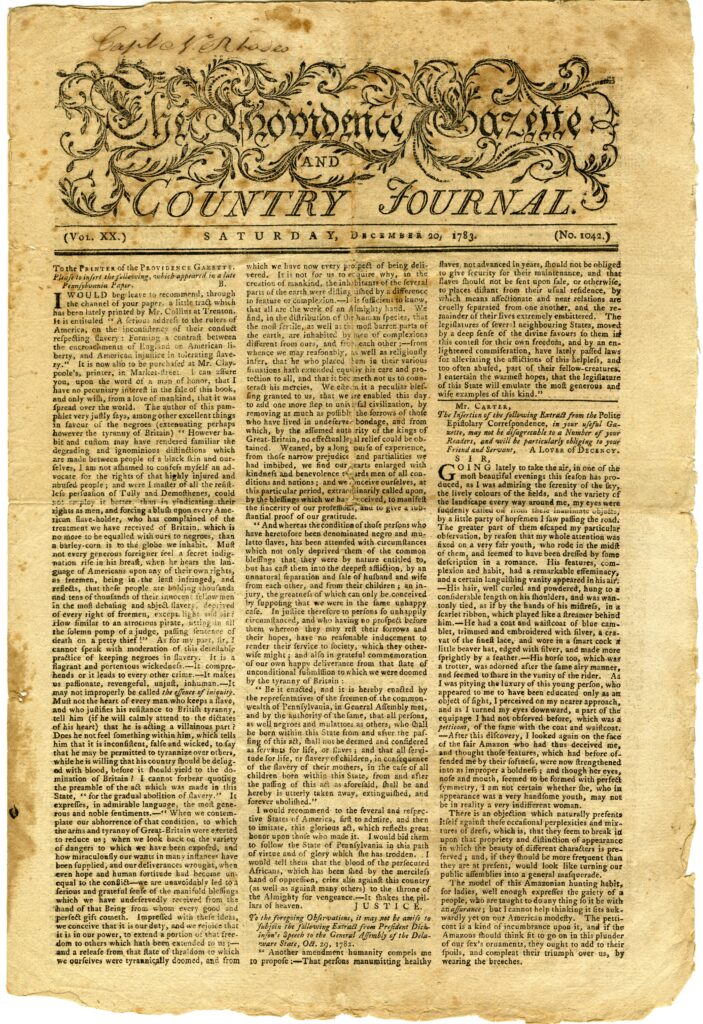
The Providence Gazette and Country Journal
Providence: W. Goddard, December 20, 1783The Robert Charles Lawrence Fergusson Collection
This issue reports on George Washington’s farewell to officers at Fraunces Tavern, recounting his speech and detailing his upcoming travels to Whitehall, Paulus Hook, Philadelphia and Annapolis, comparing his travel home to Cincinnatus: “immediately after which his Excellency will set out for his seat, named Mount-Vernon, in Virginia, emulating the example of his model, the virtuous Roman General, who, victorious, left the tented field, covered with honor, and withdrew from public life, otium cum dignitate.” Additionally, this issue features a reprinting of a British editorial critical of the Treaty of Versailles.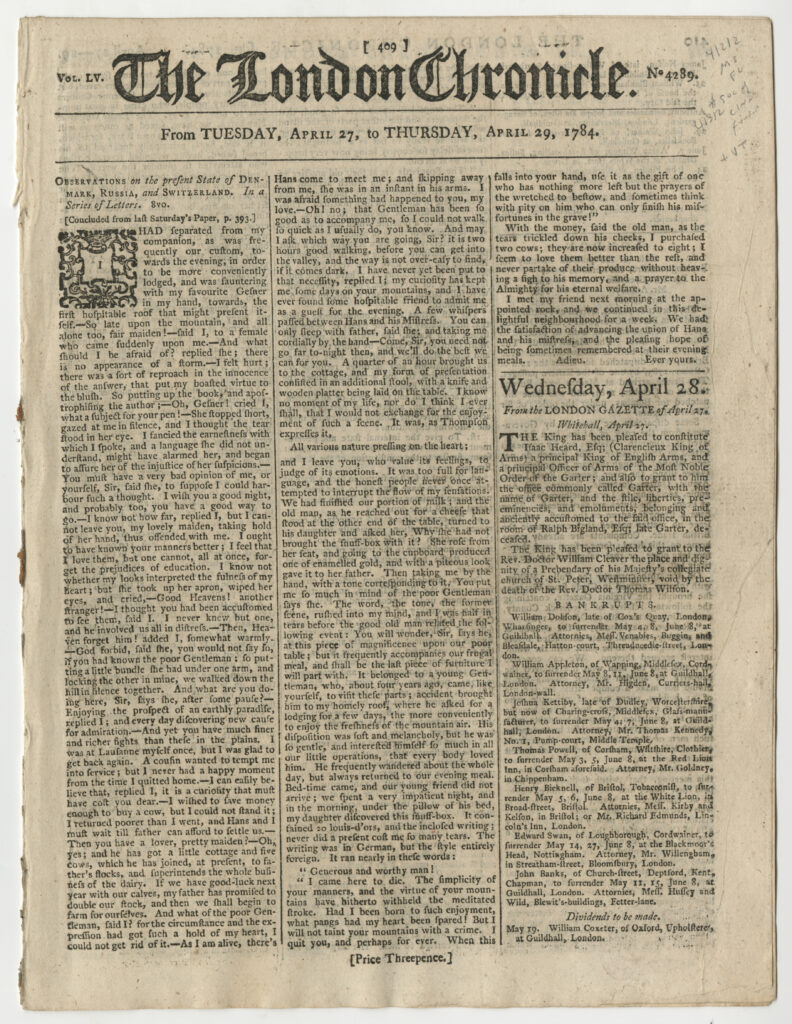
The London Chronicle
London: Sold by J. Wilkie, April 27-29, 1784Library purchase, 2008
A report from the West Indies from February 28 stating, “We learn from America that a Society or order, which has been established throughout every state in the union, termed the Society of the Cincinnati, consisting of the General and other Officers of the army, has begun to create no little apprehension for their liberties in the minds of some of their patriots” is presented in this issue. The piece goes on to describe a pamphlet written by a “celebrated Lawyer of South Carolina, reprobating this institution, tending to prove, that it creates a race of hereditary Patricians or nobility.” This lawyer was Aedenus Burke, who wrote Considerations on the Society or Order of Cincinnati.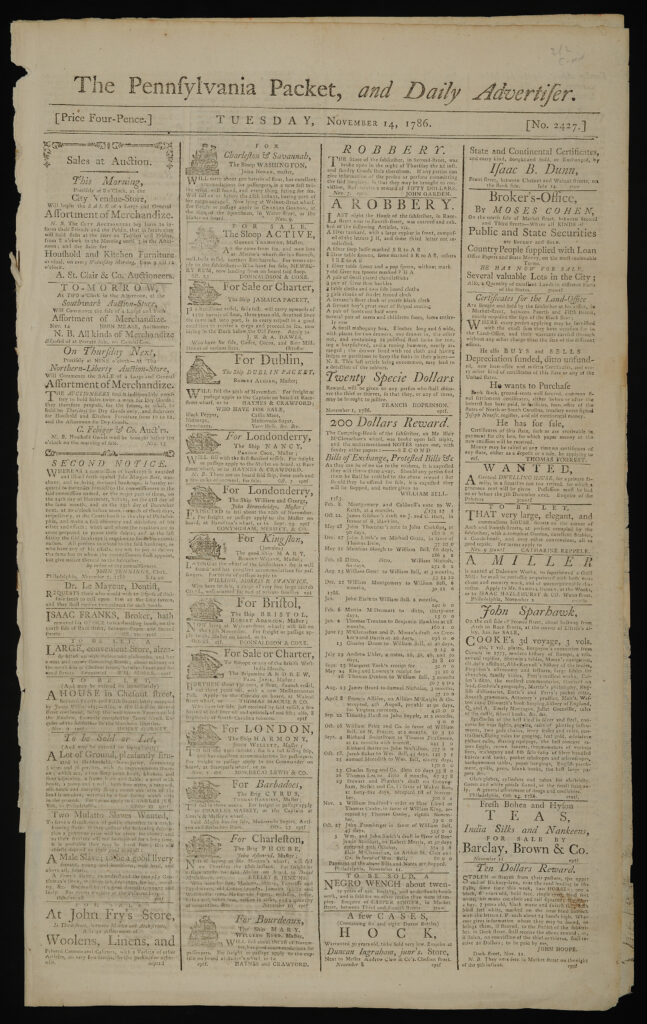
The Pennsylvania Packet
Philadelphia: John Dunlap, November 14, 1786Library purchase, 2009
This paper provides coverage of a Society of the Cincinnati of the State of Georgia meeting ending with thirteen toasts. The Georgia Society held a quarterly meeting on October 26 where they appointed honorary members Lt. Nicholas Anciaux, Esq., Brig. Gen. Duplessis and Brig. Gen. James Jackson; and admitted Monsieur de la Beaume, baron de Malves, as an original member. With no further business at the meeting, the Society had dinner and drank thirteen toasts. It was common practice after the war to drink thirteen patriotic toasts honoring the thirteen original states. Notably, these toasts from Georgia recognize Count d’Estaing, General Knox (“one of the first institutioners”), and “All good men,” and declare, “May the American navy be as triumphant as her armies have been over all their enemies.”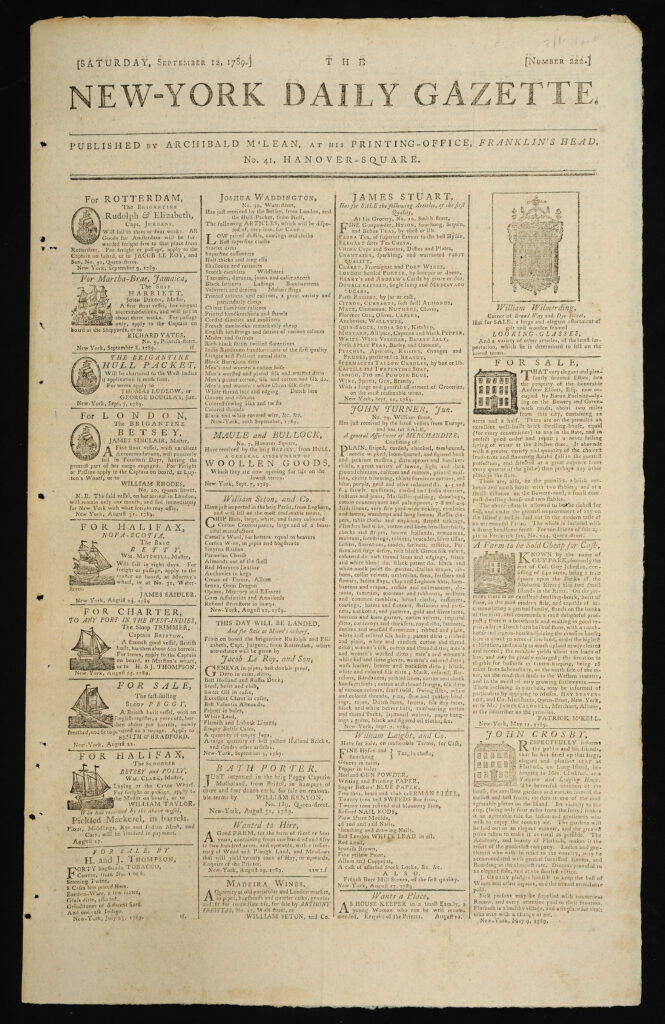
The New-York Daily Gazette
New York: Published by J. & A. M’Lean, September 12, 1789The Hamilton Newspaper and Ephemera Collection of Antonia Chambers, Esq.
What would be front page news today is tucked into the first column of the third page of this newspaper: the announcement of Alexander Hamilton’s nomination by President Washington as the first secretary of the treasury. This paper also contains news from Paris and London, a sketch of the proceedings of Congress and political maxims.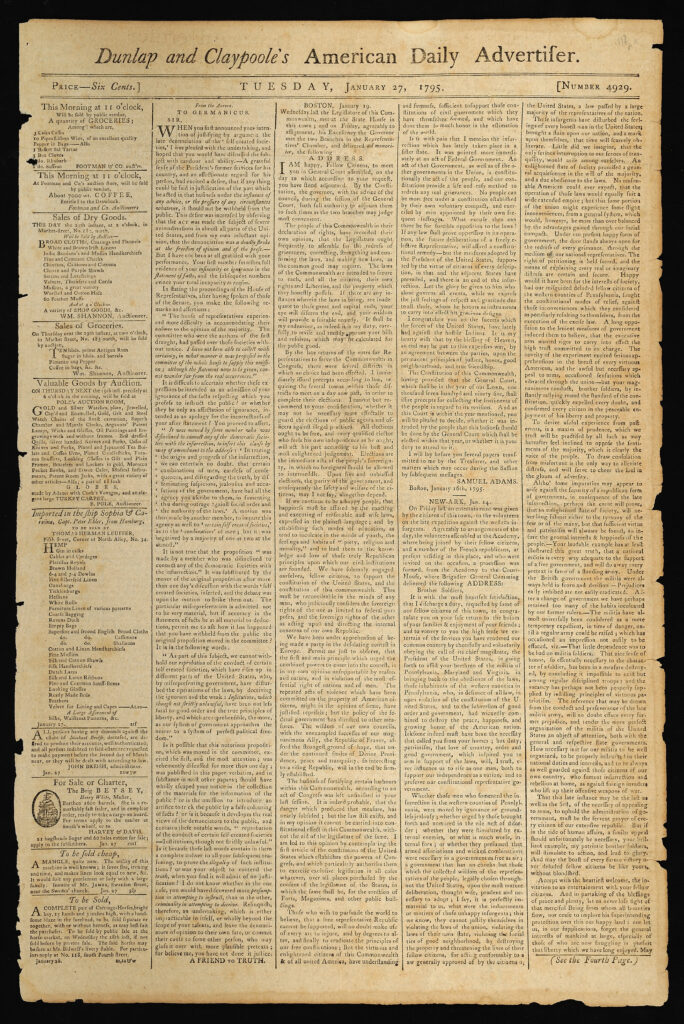
Dunlap and Claypoole’s American Daily Advertiser
Philadelphia: Printed and sold by John Dunlap and David C. Claypoole, January 27, 1795The Hamilton Newspaper and Ephemera Collection of Antonia Chambers, Esq.
Many papers of the era featured published toasts that were given at an event. This paper features a list of thirteen toasts given at a dinner in Philadelphia for Col. Francis Gurney. Included are toasts to Alexander Hamilton (“Alexander Hamilton, Secretary of the treasury—May his successor in office emulate his virtues”), the marquis de Lafayette (“May he soon be liberated from his captivity, and enjoy that liberty which he fought to bestow upon others”), the Constitution of the United States and the “Rights of Woman.” Additionally, there is an article on a lottery to improve the “Federal City.”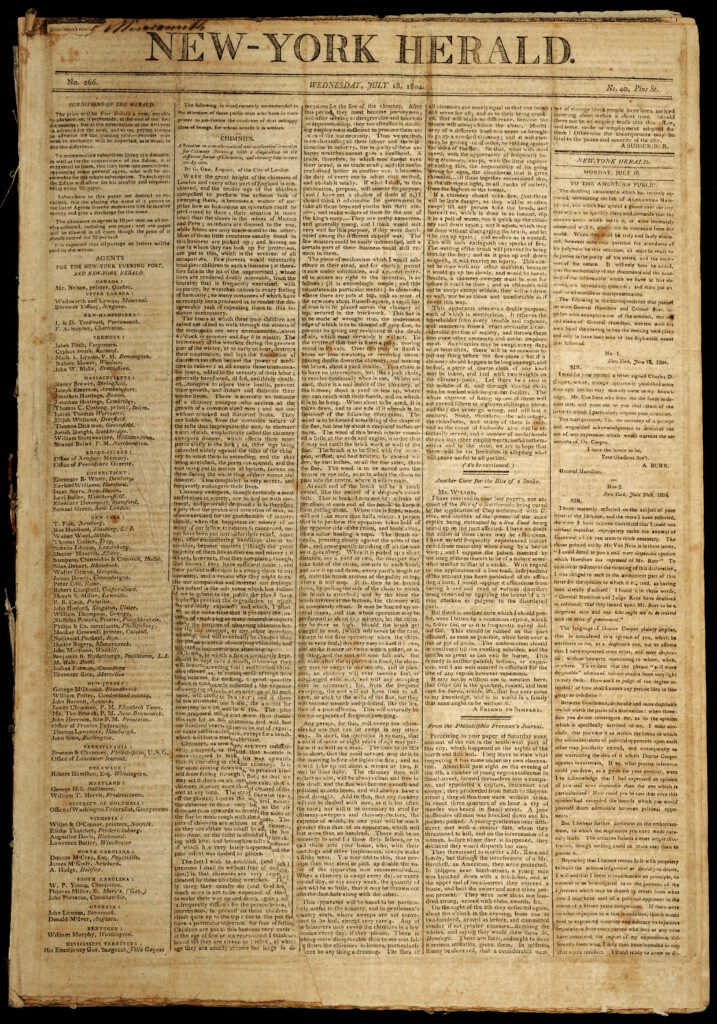
New-York Herald
New York: Printed & published by Michael Burnham, July 18, 1804The Hamilton Newspaper and Ephemera Collection of Antonia Chambers, Esq.
Alexander Hamilton died on July 12, 1804. Nearly one third of the newspapers in the Hamilton Newspaper and Ephemera Collection of Antonia Chambers, Esq., feature coverage on the Hamilton-Burr duel, Hamilton’s death and funeral and public reaction in the aftermath. This paper contains a two-page spread of Hamilton content including “the correspondence that passed between General Hamilton and Colonel Burr, together with an explanation of the conduct, motives and views of General Hamilton, written with his own hand the evening before the meeting took place and only to have been seen in the deplorable event that followed” and coverage of the funeral procession for Hamilton. Alongside a woodcut engraving of his coffin, the paper asserted, “That distant readers may form some idea of what passed on this mournful occasion, we shall here present them with a regular and correct account of the whole scene.”